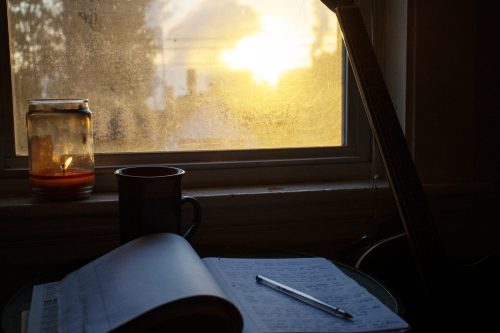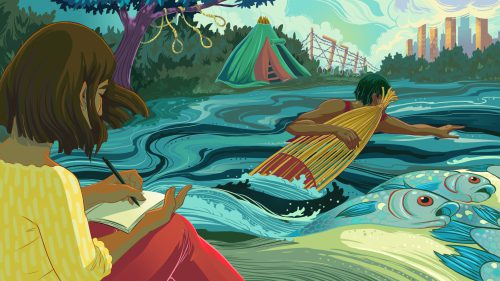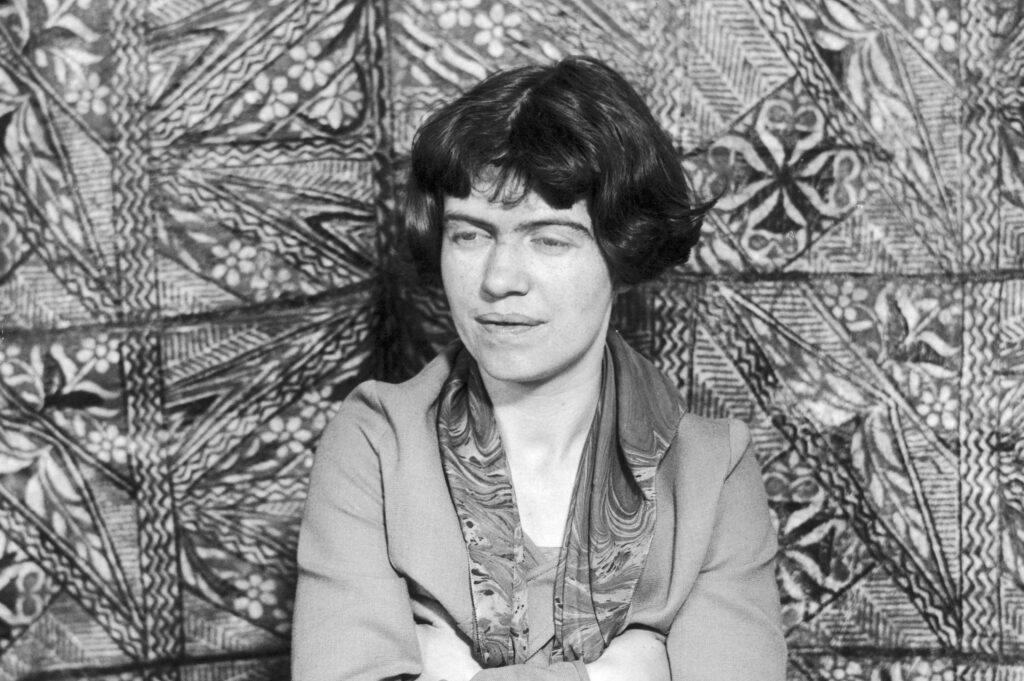Anthropological Poetry

In this unit, students will learn how anthropological poetry deftly draws readers into a moment, image, sensation, metaphor, or inquiry—less so into an argument, proof, or explanation. As a creative expression, this subgenre of poetry allows for an embodied multiplicity of insights and emotions shared by skilled participant-observers or researchers. Students will explore how anthropologists turn toward poetry to process, reflect on, and share their fieldwork, personal/communal experiences and emotions, and/or research.

What Is Anthropological Poetry?

Why Poetry + Anthropology?

An [un]Heroic Journey

Uncovering an Archaeology of U.S. Empire in Panama

Earworm

When Wartime Plunder Comes to Campus

How Virtual Reality Is Restoring Liberia’s Culture

A Poetics of Liberation: An Imagined Archive

How Women Shaped Human Evolution Through Food Processing

Snapshots of Losing Jenna

What Vietnam’s Scarred Lands Reveal About Modern Warfare

Uncovering an Archaeology of U.S. Empire in Panama

Earworm

Reclaiming Collective Life in a Fractured U.S.

Why Do Swallows Fly to the Korean DMZ?

A Poetics of Liberation: An Imagined Archive

Debitage

Tracing Roti’s Pasts, Presents, and Futures

Pequi Winds

Heaven on Earth and Jesus Is Palestinian

Forest as Kin and Pantry in the Himalayas

Earworm

Erasure I and Erasure VI

Tallahassee Ghazal

Pequi Winds

Translation Notes

Forest as Kin and Pantry in the Himalayas

In Japan, Rethinking What It Means to Care for the Dead

Huh? The Valuable Role of Interjections

Tallahassee Ghazal

Debitage

Broken Sonnets for the Anthropocene
- Some cultural anthropologists express themselves through “ethnographic poetry” to communicate their emotions, thoughts, and fieldwork outside the constraints of academic writing and publishing. They may use poetry to complement but also question representation in the practice and writing of ethnography.
- Biological anthropologists, archaeologists, and linguistic anthropologists who do not engage with ethnography also turn to poetry to share their emotions, insights, and research findings.
- “Autoethnographic poetry” offers insights or critical reflections on one’s own self and community, family, lineage, or a broader social context.
- “Anthro-poetry” is an umbrella term for anthropologically informed poetry written by scholars in any field of anthropology.
- Some anthropologists view writing poetry as itself a research method because it offers scholars space for exploration, teasing out paradoxes and contradictions, incorporating sensory experiences, inquiring into silences, and so on. Their poems in turn may help shape their academic writings.
- The craft elements of poetry (imagery, metaphor, line breaks, alliteration, rhyme, rhythm, et cetera) can help convey “information” or “data”/“reporting” in a poem. However, in a well-crafted poem, information does not drive or overwhelm the craft elements. This makes poems enjoyable and readily engaging.
-
Article: Maynard, Kent and Melisa Cahnmann-Taylor. 2010. “Anthropology at the Edge of Words: Where Poetry and Anthropology Meet.” Anthropology and Humanism 35 (1): 2–19.
-
Article: Richardson, Miles. 1994. “Writing Poetry and Doing Ethnography: Aesthetics and Observation on the Page and in the Field.” Anthropology and Humanism 19 (1): 77–87.
-
Poem: Vasser-Elong, Jason. 2022. “Purple in Cycles,” SAPIENS, October 31.
-
Poem: Thomas, Gwynfryn. 2022. “The Spring a Time for Calving and Cleaving,” SAPIENS, January 17.
-
Poem: Wright, Justin D. 2020. “The National Lynching Memorial Speaks to My Black ’Bama Body or Imma Be Here Forever, You Gon’ Remember This,” SAPIENS, April 7.
- In their article, Maynard and Cahnmann-Taylor say that an ethnographic poet and the poetic ethnographer must write into “what one does not know yet” and to “what one already knows.” How does Thomas’ poem do this? What does he know about Sámi reindeer herding? What does he not know about reindeer herding and about the Sámi?
- How does bringing together poetry and ethnography blur dichotomies between science and art, inward-focused writing versus engaging outward, and aesthetics and observation?
- What poetic tool does Vasser-Elong use in his poem to create a feeling of entrapment in the first three stanzas? Notice how the sound of the poem matches that feeling. How does he use the same tool in the last stanza to create a sense of movement out of the poem toward freedom? What other kinds of meaning does the poet evoke with the symbol of the labyrinth?
- How does Wright make the lynching memorial feel both personal and political? How does the poet counter, with the fact of the poem itself, what the speaker’s Grandma says, “the past don’t never forget though we might”?
- What are the many meanings and contradictions Wright is speaking to in the following lines?:
“a fullness in its empty, an empty in its full,
a place made to be left, a space made to leave a hope upon,
an altar”
- Poets and anthropologists often rely on imagery and lively description to make their writing compelling. Write a poem that starts with an image, moves to the emotional content of that image, and then relates those emotions to a community you’ve studied this semester that is not your own. Be sure to incorporate some of the craft elements of poetry. (See the Poetry Foundation’s Glossary of Poetic Terms for more information.)
- Visual storytelling through well-chosen images can make poems even more engaging and alive. Create a 60-second video for one of the poems in the “Academic Articles and Poems” section or a different SAPIENS poem. Overlay clips from accompanying audios to align with the images.
- Make a poetic record of something about your family or community that is rarely talked about but that you feel needs to be remembered. Try to make the “sound” of the poem match the “sense” or “record” of the poem.
- Write a poem starting with what you do know, and at a key turn in the poem, shift to what you don’t know yet.
-
Article: Ivan Brady’s “In Defense of the Sensual: Meaning Construction in Ethnography and Poetics”
-
Article: Dell Hymes’ “Comment: Anthropology and Poetry”
-
Article: Catherine Trundle and Susan Wardell’s “The Meaning of Pain: Exploring the Intersections of Poetry and Ethnography”
-
Book: Renato Rosaldo’s The Day of Shelly’s Death: The Poetry and Ethnography of Grief
-
Essay: Nomi Stone and Leah Zani, The Kenyon Review, “Battlefields, Fieldpoems”
-
Lecture: Fred Moten’s Poetics of the Undercommons
-
Podcast: Cory-Alice André-Johnson, Anthropod, “What Does Anthropology Sound Like? Poetry,” featuring poet-anthropologists Darcy Alexandra and Ather Zia
-
Video: Audre Lorde’s “Poetry Is Not a Luxury”
-
Video: Gina Athena Ulysse’s “Remixed ode to rebel’s spirit”
-
Webinar: Jason Vasser-Elong’s “Rhyme & Reason: Poetry as a Cultural and Communal Bridge”
-
Webinar: Justin D. Wright’s “The Emotional Logic of a Black Poetics: Truth, Metaphor, Beauty, Joy”
Marlaina Martin and Christine Weeber (2023)
Margaret Mead in American Samoa
